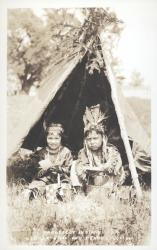"Now," Glooskap announced, "it is time for me to make human beings." The animals of the forest crowded around. "What I'm about to do," Glooskap said, "is mysterious." Glooskap used a powerful magic that he had saved for this moment.
He waved his arms, smoke flew up from the ground, there was a blinding light so that the animals had to throw themselves to the ground, covering their eyes. They were afraid. But when they next looked up, they burst into laughter. They saw human beings setting out in all directions: north, south, east, and west. "Look!" a bear shouted, "they walk on two feet!" — Penobscot Creation Story

Glooskap Setting His Dogs on the Witches, ca. 1884
Maine Historical Society
Introduction
The federal census of 2000 provides this snapshot of Maine: 1,274,923 residents (well under 1 percent of the nation's 300 million), 96.7 percent of whom are white, with less than 1 percent each of African-American, Latino, Asian, and Native American descent.
Although population density is 41.3 persons per square mile (about half of that of the United States as a whole), most are concentrated in the relatively urban southwest.
Glimpsed in the form of aggregate data, the state's demographic profile appears singularly monotonous; expressed in the form of a narrative; however, the image unfolds far more vividly.
The view of Maine's people as a monolithic society is misleading. Many strands –– native peoples, immigrants from across Europe and beyond in Colonial times and after, Americans from elsewhere, immigrants, slaves, refugees, migrant workers, and summer residents –– have woven texture and color into the canvas of Maine society.
These strands constitute the peopling of Maine from prehistoric migrations of hunter-gatherer bands to the more recent influx of Somali refugees and Mexican and Central American migrant workers. The resulting portrait may look bland from a distance, but viewed up close and over time many variations appear.

Illustration for 'Evangeline: A Tale of Acadie,' ca. 1880
Maine Historical Society
Over the generations, immigrants have come to Maine for a combination of complex reasons: economic opportunities, wars or other conflicts in the homeland, agricultural or economic crises in the homeland, or the appeal of Maine's relative remoteness and wilderness, among others.
As layers upon layers of immigrants moved into and around the state, newcomers adjusted to life in Maine and newcomers and the existing residents made accommodation to each other, although not always easily or peacefully.
Of course the story of the peopling of Maine cannot be told without acknowledging the un-peopling of Maine as well. Acadian expulsion sent refugees far from their homes following British victory in colonial wars. Some later reconstituted around the St. John River valley joining French Canadians to form small farming communities, but many took their talents and culture to New Orleans and elsewhere. Patriot pressures and subsequent victory in the American Revolution compelled loyalists to abandon their farms and homes and relocate to New Brunswick or to Britain.
Other immigrant groups came with the intention of returning to their homes, and some did return. Even now, the outward migration of Maine's rising generation is a familiar if dismaying phenomenon. The largest case of depopulation, however, came at the expense of Maine's native peoples whose numbers were devastated beyond reckoning following exposure to European diseases, and through the colonizing processes of war and settlement.

Lucille Shay and Teddy Solomon, Indian Island, ca. 1920
Maine Historical Society
The First People
Much has been made of the Great Ice Age with its Bering Strait connection to Asia. The eastward migration of people and other large mammals across that land bridge, and the subsequent peopling of the Americas in a one way migration following the glaciers' retreat has been debunked.
Archeologists refer to the continent's earliest occupants as Paleo-Indians, and most agree humans have occupied the region for nearly 12,000 years. That may be, but things look different from the Native American perspective, whose traditions and stories tell them Glooskap, First Mother, or another Great Spirit Creator birthed them in place.
Kennebec, Penobscot, Micmac, Passamaquoddy, Androscoggin, Maliseet, and other tribes spread across the eastern Maritimes and related watersheds. Eventually, many of these groups created the Wabanaki Confederation, a loose organization that met as needed to decide mutually advantageous policies, and to better deal with Iroquois threats from the west.
Drawing strength and meaning from their respective territories, and establishing both political and trading alliances with others, Maine's native peoples spent hundreds of years perfecting a way of living that supplied most of their needs most of the time.
Incursions from the north and west occasionally threatened their security, and targeted conflicts amongst themselves sometimes depleted supplies, proved a warrior's mettle, or brought fresh captives to replenish those lost in earlier raids, but the broad integration of people and place fostered tribal and clan identities.










